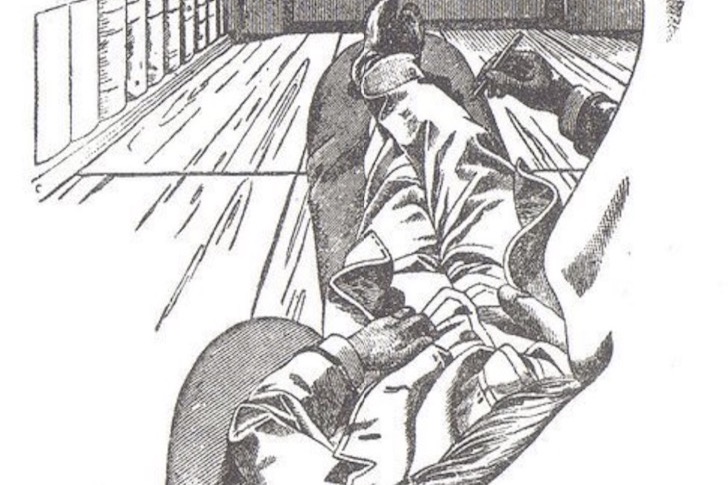Douglas Harding
This is the simplest and most fun way to answer the perennial question: Who am I?
After seeing a self-portrait by Ernst Mach, Douglas Harding spontaneously awoke. The painting was what you see when you look down at your body: a torso, two arms and two legs.
‘Brilliant!’
He instantly realised he had no head.
Have you ever seen your head?
It’s unlikely. Our eyes receive different wavelengths of light that fall on the retina at the back of each eye. This is a 2D image. The brain matches the two and uses parallax to create a 3D image. It adds things it expects to see and removes those it doesn’t. If you shut one eye, there’s no black hole where the optic nerve exits the retina. Your brain guesses what’s nearby and fills it in. This can explain the car accident: ‘Sorry, I didn’t see you!’ We weren’t expecting to see the bicycle or motorcyclist, so the brain removed them.
Douglas’s website headless.org has a section for ‘Exercises’. What follows is my tweaked version of his Pointing game.
Point to a couple of objects nearby and speak their names, e.g. ‘dog’ and ‘tree’. Now reverse your pointing finger and point at your own head: ‘I’. It’s interesting that whenever we point at anything there are always three fingers pointing back at ourselves.
Ask yourself Where is my ‘I’, where is my ‘I Am’?
Well it’s obvious isn’t it? ‘I’ am in my head.
Ok, let’s investigate a bit further.
Move your finger towards your nose.
Have you ever seen your nose?
Probably not. A reflection is a mirror and a reflection of an imaginary projection.
Stop when you touch your nose.
Here’s a slight digression into quantum physics.
Why did your finger stop?
Because matter reached matter?
Alas, quantum physics shows that matter doesn’t exist. Everything is energy. As Tesla said, “If you want to find the secrets of the universe, think in terms of energy, frequency and vibration. Things we think of as physical matter are actually an illusion. The quantum realm is reality, where all possible states exist at the same time. By using free will, we choose the one we want to manifest in this world.
This explains why happy people have happy thoughts and happy lives, and unhappy people the reverse.
Our thoughts create the world we expect to see.
Just as the observer affects the observed, the observed affects the observer in an instantaneous feedback loop by creating their ‘reality’.
Back to biology.
Your finger is on your nose.
What is it made of? It’s a lot of cells.
What are cells made of? Molecules.
What’s a molecule? Lots of atoms joined together.
What is an atom? Well, the first thing is that no one’s ever seen an atom. It’s a mental construct, a theory to explain quantified data. The model is a dense nucleus with a positive electrical charge with electrons whizzing around it in a negatively charged electric ‘cloud’.
We also know they are 99.9999999% empty space.
To an approximate scale, if the nucleus was the size of an orange, the nearest electron would be 20 metres away.
Thus, we continue our pointing journey through the atom and oops!
I’ve gone clear through what I thought was my head because there’s nothing there!
So what am I?
I am a single point of awareness.
Buddhists have studied the perennial questions for thousands of years with logic, evidence, and reason, and they cannot find an ’I’.
It gets better.
Imagine an orange again, but at a different scale. It has a light inside it.
There are many pinholes through which light shines. Each of us is a pinhole. Although we think we are separate, there is only one light, one mind and one consciousness.
Thus, ‘the eye that sees me is the same as the eye that sees you.’
When you meet someone with radiant eyes, it means the source shines more brightly through them. They are a ‘shinier tap’, so its energy is more visible. The brightness is love. We are all made of love. Everything in the universe is made of love.
It gets even better.
I am a single point of awareness driving around in my body, my ‘vehicle’.
This is why actors call their bodies ‘vehicles.’ When they take on another character, they channel them so the character’s persona flows directly through them. They get their own persona out of their own way.
It gets better still.
Where do the characters’ thoughts come from?
If the actor is channelling another character, it makes sense it’s coming from outside his body. Perhaps his brain’s acting like a radio receiver? If so, he’s tuned into the frequency of the character he wants to portray.
Maybe that’s how we receive thoughts – they reflect the frequency we are tuned into. Thus, a happy person has happy thoughts – tuned to a high frequency, and an unhappy person receives unhappy thoughts via a low frequency.
What if these thoughts were energy beings in their own right who are constantly vying for our attention?
Everyone wants to drive.
Driving is fun.
References
| Media | Author/Director | Title |
|---|---|---|
| Book | Douglas Harding | On Having No Head |
| Website | Douglas Harding | The Headless Way |
| Book | Douglas Harding | The Face Game |
